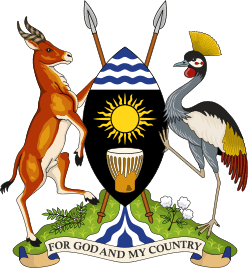Elections in Uganda
 |
| This article is part of a series on the politics and government of Uganda |
|
Judiciary |
|
| Foreign relations |
Uganda provides national elections for a president and a legislature. The president is elected for a five-year term. The Parliament is composed of members directly elected to represent constituencies, and one woman representative for every district; as well representatives of special interest groups, including the army, youth, workers and persons with disabilities.
Overview
The first national election in Uganda was the Uganda National Assembly election of 1962. An alliance between the Uganda People's Congress (UPC) and Kabaka Yekka (KY) won the majority of parliamentary seats, and formed Uganda's first post-independence government with Obote as executive Prime Minister.[1]
A period of dictatorship and political strife, including the tenures of Idi Amin, Yusuf Lule and Godfrey Binaisa, meant no elections were held until the presidential election of December 1980. Obote was pronounced the winner amid bitter dispute and allegations of electoral fraud. Yoweri Museveni, one of the presidential aspirants, declared an armed rebellion, and waged a guerrilla war (the Ugandan Bush War) against the government of Obote. Museveni's National Resistance Army (NRA) took power in 1986 from the government of Gen. Tito Okello Lutwa who had six months earlier toppled Obote's UPC government in a July 27, 1985 military coup, making him President.
Museveni and his National Resistance Movement (NRM) created a form of "no-party democracy", banning political parties from fielding candidates directly in elections.[2] In the "no-party" presidential election in 1996, Museveni defeated Paul Ssemogerere and Mohamed Mayanja by a landslide. Although international and domestic observers described the vote as valid, both the losing candidates rejected the results.[2] In the following presidential election, held in 2001, Museveni won by a substantial majority, with Kizza Besigye as the only real challenger. Despite a protest against the results, citing massive voter intimidation and rigging, the outcome was accepted by the Supreme Court of Uganda.
In the 2005 constitutional referendum, Ugandans voted to restore a multi-party political system, lifting the 19-year restriction on the activities of political parties. The 2006 general election was the first multiparty election in 25 years. Museveni won 59% of the presidential vote, and his party, the National Resistance Movement, won the majority of parliamentary seats.
Latest elections (February 2006)
| Candidates - nominating parties | Votes | % |
|---|---|---|
| Yoweri Museveni - National Resistance Movement | 4,109,449 | 59.26 |
| Kizza Besigye - Forum for Democratic Change | 2,592,954 | 37.39 |
| John Ssebaana Kizito - Democratic Party | 109,583 | 1.58 |
| Abed Bwanika - Independent | 65,874 | 0.95 |
| Miria Obote - Uganda People's Congress | 57,071 | 0.82 |
| Total | 6,934,931 | 100.00 |
| Source: New Vision newspaper, Electoral Commission of Uganda | ||
| Parties | Votes | % | Constituency seats |
District woman reps. |
Indirect seats |
Total seats |
|---|---|---|---|---|---|---|
| National Resistance Movement | 142 | 49 | 14 | 205 | ||
| Forum for Democratic Change | 27 | 10 | - | 37 | ||
| Uganda People's Congress | 9 | - | - | 9 | ||
| Democratic Party | 8 | - | - | 8 | ||
| Conservative Party | 1 | - | - | 1 | ||
| Justice Forum | 1 | - | - | 1 | ||
| Independents | 26 | 10 | 1 | 37 | ||
| Vacant | 1 | - | - | 1 | ||
| Uganda People's Defence Force Representatives | 10 | |||||
| Ex-officio members | 10 | |||||
| Total (turnout 72 %) | 215 | 69 | 15 | 319 | ||
| Source: Inter-Parliamentary Union | ||||||
|
Note on the Distribution of seats: | ||||||
Past elections
General elections December 1980
| Party | Seats |
| Uganda People's Congress | 73 |
| Democratic Party | 52 |
| Uganda Patriotic Movement | 1 |
| Conservative Party | 0 |
| Total seats | 126 |
| Source: Uganda, 1979-85: Leadership in Transition (1988), Jimmy K. Tindigarukayo | |
Presidential elections 1996
| Candidate | Percentage |
| Yoweri Museveni | 75.5% |
| Paul Kawanga Ssemogerere | 22.3% |
| Muhammad Kibirige Mayanja | 2.2% |
| Turnout | 72.6% |
| Source: The Electoral Commission of Uganda: Presidential Elections Results 1996 | |
Presidential elections 2001
| Candidate | Number of votes | Percentage |
| Yoweri Museveni | 5,123,360 | 69.4% |
| Kizza Besigye | 2,055,795 | 27.7% |
| Aggrey Awori | 103,915 | 1.4% |
| Muhammad Kibirige Mayanja | 73,790 | 1.0% |
| Francis Bwengye | 22,751 | 0.3% |
| Karuhanga Chapaa | 10,080 | 0.1% |
| Turnout | 7,511,606 | 69.7% |
| Source: The Electoral Commission of Uganda: Uganda Presidential Elections March 2001 | ||
Multiparty referendum 2005
"Do you agree to open up the political space to allow those who wish to join different organisations/ parties to do so to compete for political power?"
| Option | Number of votes | Percentage |
| Yes | 3,643,223 | 92.4% |
| No | 297,865 | 7.6% |
| Turnout | 3,941,088 | 47.3% |
| Source: The Electoral Commission of Uganda | ||
Source: [ Uganda Electoral Commission ]
See also
References
- ↑ History of Parliament (Website of the Parliament of Uganda)
- 1 2 Nelson Kasfir (1998). ""No-Party Democracy" in Uganda". Journal of Democracy. 9 (2): 49–63. doi:10.1353/jod.1998.0029.
External links
- Museveni's Win in the 2011 Elections: What Does it Mean For Uganda's Politics?
- Uganda Electoral Commission
- Adam Carr's Election Archive
- African Elections Database
- Voter turnout, Gender quotas, Electoral system design and Political party financing in Uganda